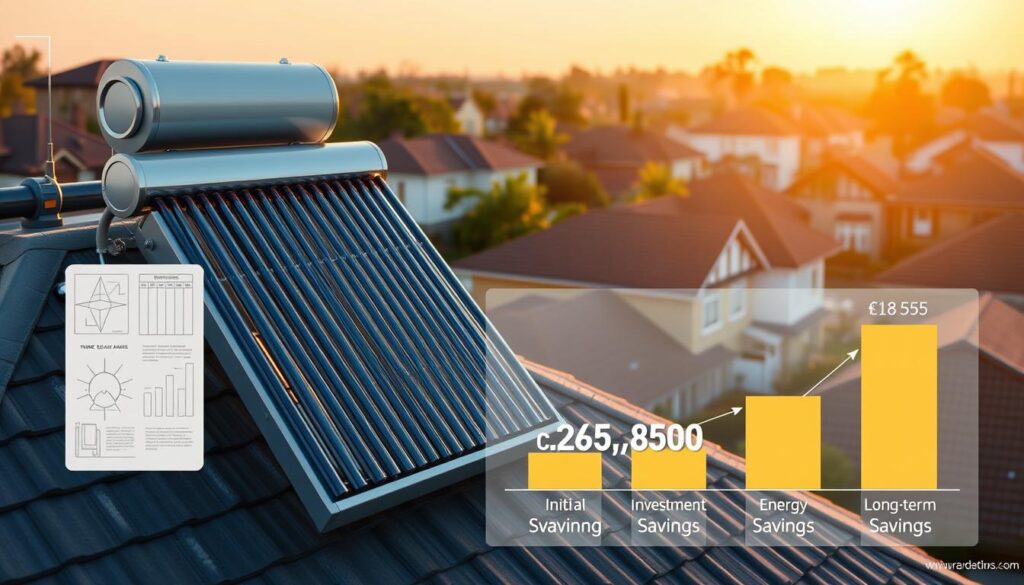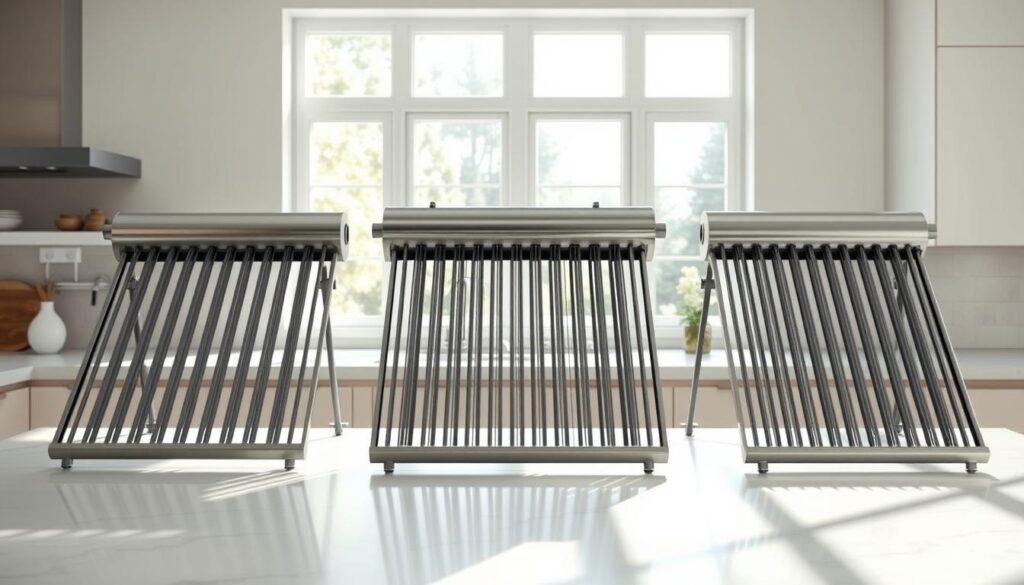Imagine cutting your water heating costs by harnessing sunlight. A home solar water heater uses renewable energy to warm household water, slashing reliance on gas or electricity. The average U.S. household spends nearly $300 yearly on water heating, which makes up 14% to 18% of monthly energy bills. These systems capture solar energy through collectors and storage tanks, turning sunlight into hot water year-round. With federal tax credits and long-term savings, residential solar water heater technology is becoming a smart choice for eco-conscious homeowners.
Key Takeaways
- Solar water heater for home systems can reduce energy bills by up to 80%.
- A federal tax credit of 30% applies until 2032 for eligible purchases.
- Systems last 20-30 years, offering decades of savings.
- South-facing roof space is critical for optimal performance.
- Installation costs start at $2,000, with tax breaks lowering upfront expenses.
Understanding Home Solar Water Heaters
Home solar water heaters turn sunlight into hot water, offering an eco-friendly home solar water heater solution for daily needs. These systems capture solar energy, convert it to heat, and store it for use. Let’s break down how they work and what they need to function effectively.
How Solar Water Heating Works
Active systems use solar collectors on roofs. A fluid flows through these panels, absorbs heat, and transfers it to a storage tank via a pump. Passive systems rely on natural convection, using gravity and temperature differences to move water without pumps. Both types harness free sunlight to reduce energy bills.
Types of Solar Water Heating Systems
- Active Systems: Include pumps and controls, ideal for most climates.
- Passive Systems: Use no pumps, making them simpler but less efficient in extreme cold.
Active systems are common in the U.S., while passive setups work well in mild climates.
Key Components and Their Functions
All systems have three main parts:
- Collectors: Absorb sunlight. Flat-plate panels are common; evacuated tubes offer higher efficiency in cold areas.
- Storage Tanks: Hold heated water, often with extra inlets/outlets. Some combine with traditional heaters for backup.
- Heat Exchangers: Transfer heat from fluid to water without mixing. Pumps (in active systems) circulate fluids.
Maintenance is minimal—every 3–5 years for basic systems. Backup heaters ensure hot water on cloudy days.
Benefits of Installing a Solar Water Heater in Your Home
A sustainable home solar water heater transforms daily living by cutting costs and protecting the planet. These systems are a cost-effective home solar water heater solution, reducing energy bills by up to 50% and qualifying for tax credits. Over 20 years, the savings and environmental impact make this a smart upgrade for any household.
“Our solar system paided for itself in 7 years and now saves us $300 yearly!”
- Energy savings: Reduce water heating costs by 30–80% annually.
- Environmental impact: Zero-emission operation lowers household carbon footprints.
- Financial perks: Federal tax credits and state rebates reduce upfront costs.
- Home value: Solar systems boost resale appeal by up to 20% in some markets.
A cost-effective home solar water heater installation can start at $9,000 before incentives, but monthly savings add’t stop there. Systems with ENERGY STAR certification also qualify for federal rebates, lowering initial costs further. With minimal maintenance—like annual inspections and descaling every 3–5 years—these systems operate for decades.
The sustainable home solar water heater option aligns with modern energy trends, providing reliable hot water even during power outages. For families in sunny regions, the benefits multiply, with savings rising alongside sunlight exposure. Start saving today while building a greener future for your home.
How a Home Solar Water Heater Reduces Your Carbon Footprint
Reducing your carbon footprint starts with everyday choices like your home’s water heating system. A sustainable home solar water heater slashes greenhouse gas emissions while cutting energy costs. By replacing fossil fuel-dependent systems, homeowners can make a measurable environmental impact.
Traditional water heaters rely on gas or electricity, contributing to 18% of household energy use. In contrast, a energy-efficient home water heater powered by the sun produces zero direct emissions. Here’s the difference:
- Average annual CO2 reduction: 1–2 tons per year
- Over 20 years, systems prevent up to 30 tons of CO2 emissions
- Traditional systems emit 4.6 metric tons of CO2 yearly (vs. solar’s zero operational emissions)
Going solar qualifies households for renewable energy credits (RECs), which utilities can purchase, creating extra income. Federal tax credits (up to 30%) also offset upfront costs. These systems also:
- Reduce fossil fuel dependency by 50% for hot water needs
- Prevent 40,000 kWh of grid electricity use over 20 years (as seen in California case studies)
- Help meet local renewable energy goals through clean energy production
- Reduce fossil fuel dependency by 50% for hot water needs
- Prevent 40,000 kWh of grid electricity use over 20 years (as seen in California case studies)
- Help meet local renewable energy goals through clean energy production
Every household adopting a sustainable home solar water heater contributes to cleaner air and resource preservation. With long-term savings and environmental impact, the shift to solar is a win for both the planet and your wallet.
Cost Analysis: Initial Investment vs. Long-Term Savings
Switching to a residential solar water heater starts with understanding costs and savings. While upfront expenses range from $5,000 to $10,000, incentives and long-term savings make these systems a cost-effective home solar water heater option. Federal tax credits and state rebates reduce initial outlays, while energy savings add up over time.

Typical Installation Costs for Residential Systems
Costs vary by system type and location. A basic system starts around $5,000, while advanced models can reach $10,000. Labor, regional permits, and system size affect pricing. Federal tax credits (up to 30% via the ITC) and state rebates lower these figures significantly.
Monthly Utility Savings Expectations
- Gas-powered homes save $25–$40 monthly.
- Electric users save $30–$60 monthly.
- Annual savings range from $300 to $720.
Payback Period and ROI Calculations
| Scenario | Upfront Cost | Annual Savings | Payback Period |
|---|---|---|---|
| California Solar | $7,000 | $500 | 14 years |
| New York Gas Heater | $1,200 | $- (no solar) | — |
| Solar (national avg) | $7,500 | $600 | 12.5 years |
Available Tax Incentives and Rebates
The federal Investment Tax Credit (ITC) reduces costs by 30%, while states like California offer additional rebates programs. Check local utility providers for further discounts. Over 20 years, these incentives boost ROI by 25%–40%.
With rising energy prices, a residential solar water heater delivers steady savings. Most systems recoup costs in 8–15 years, then provide free hot water for decades. Start calculating your savings with EnergyStar.gov tools or local installers.
Choosing the Best Home Solar Water Heater for Your Climate
Climate shapes the ideal solar water heater for your home. The best home solar water heater must match your region’s weather patterns. For instance, vacuum tube systems like ETC technology thrive in cold or low-light areas, while passive systems suit warmer zones. Here’s how to pick the right system for your environment.
- Cold climates: Opt for indirect systems with antifreeze to prevent freezing.
- Coastal areas: Choose corrosion-resistant materials to handle salt air.
- Hot regions: Direct systems work well with ample sunlight.
| System Type | Climate | Key Features |
|---|---|---|
| Active | Cold/Windy | Pumps ensure efficiency in low temperatures |
| Passive | Moderate | Lower cost, simpler installation |
| Thermosyphon | Areas with roof space | Cost-effective for moderate climates |
| Indirect | Freezing zones | Fluid protects pipes in winter |
Prices vary by capacity and design. Compare these ranges based on system size:
| Capacity (Liters) | Price Range (INR) |
|---|---|
| 100 | ₹15,000–₹25,000 |
| 200 | ₹25,000–₹40,000 |
| 300+ | ₹35,000–₹50,000 |
For top rated home solar water heater options, look for systems rated for your temperature extremes. Active systems with antifreeze are top picks in cold regions, while passive setups save costs in sunny areas. Match your choice to daily usage, climate, and budget for optimal performance.
Installation Process and What to Expect
Switching to a home solar water heater starts with a straightforward process. This guide breaks down the key phases, from assessment to final setup, ensuring clarity and ease.
Site Assessment and System Sizing
Experts first evaluate your property’s viability. They assess roof orientation, shading, and structural load. For example, south-facing roofs optimize energy capture. System size depends on household size: a 4-person home might need an 80–120 gallon tank paired with 2–4 solar collectors. Lewington Renewables uses this data to tailor each residential solar water heater plan.
Permits and Regulations
Secure required approvals before installation. Key steps include:
- Building permits for equipment mounting
- Electrical permits for backup systems
- HOA approval if applicable
Lewington Renewables handles these steps, leveraging their 20+ years of experience to streamline compliance. Their 4.7-star rating reflects reliable permit navigation.
Installation Timeline and Disruptions
Expect a 3–5 week timeline. Breakdown:
- Site evaluation: 1–3 days
- Permittingting: 1–4 weeks
- Physical installation: 1–3 days
| Phase | Duration |
|---|---|
| Assessment | 1–3 days |
| Permitting | 1–4 weeks |
| Installation | 1–3 days |
“We minimize downtime. Most clients resume use within 24 hours post-installation.” — Lewington Renewables
Temporary disruptions like water shutoffs are brief. Partnering with certified installers ensures smooth execution. Proper maintenance extends the system’s 20–25 year lifespan, as noted by the U.S. Department of Energy.
Maintenance Requirements for Sustainable Performance
Maintaining your sustainable home solar water heater ensures it operates efficiently for decades. Regular upkeep prevents costly breakdowns and keeps your energy-efficient home water heater performing at peak levels. A well-maintained system can last 20+ years, compared to 10-15 years for neglected systems.
- Clean solar collectors twice yearly to remove dust, boosting efficiency by 20-30%.
- Check pressure relief valves annually to prevent pressure buildup.
- Inspect pipes and valves for leaks every 6 months to avoid corrosion damage.
- Test glycol levels every 5 years to ensure antifreeze effectiveness.
| Task | Frequency |
|---|---|
| Collector cleaning | Every 6 months |
| Pressure test | Yearly |
| Insulation check | Bi-annually |
| Full system inspection | Every 3 years |
Professional servicing every 3-5 years addresses complex issues like antifreeze replacement. DIY tasks like visual checks and basic cleaning save costs, while certified technicians handle tasks like fluid analysis. Regular upkeep reduces repair costs by up to 25% of initial investment. Keep manuals handy and follow manufacturer warranties (typically 5-10 years for collectors).)
Comparing Top-Rated Home Solar Water Heater Brands
Choosing the best home solar water heater requires considering climate, performance, and budget. Below are standout brands and models designed to meet varied needs:

Best Systems for Cold Climates
- Surya Solar offers evacuated tube collectors (ETC) with freeze-resistant design, ideal for harsh winters.
- Tata Solar provides systems with enhanced insulation and backup heating elements for reliable performance in sub-zero temperatures.
Most Efficient Systems for Year-Round Performance
Brands like Varistor Solar deliver consistent results with ETC technology that maintains efficiency even in cloudy weather. Their systems boast 90% thermal efficiency and 20-year warranties.
Budget-Friendly Options with Solid Performance
- Supreme Solar entry-level models start at $3,000, offering flat-plate collectors with 15-year guarantees.
- Surya Solar basic kits reduce costs without sacrificing durability, perfect for moderate climates.
When comparing brands, check certifications like Energy Star ratings and customer reviews. Top-rated home solar water heater models often include smart monitoring features, while the best home solar water heater for budgets balances upfront cost with long-term savings. Always verify local rebates—states like Hawaii offer up to $750 in incentives.
Integration with Existing Home Energy Systems
Pairing a home solar water heater with existing systems can boost energy efficiency and savings. Whether updating a traditional setup or adding smart tech, seamless integration is key. Many homeowners combine solar solutions with other energy-efficient upgrades for maximum impact.
“Combining solar water heating with PV panels slashed my energy costs by over 50%.” – Michael L., Arizona
Compatibility with Traditional Water Heaters
Most systems work well alongside gas or electric heaters. Options include:
- Parallel setups where both systems supply hot water
- Series systems where solar preheats water before it reaches traditional heaters
- Hybrid systems like Rheem’s Solar Classic, which integrates seamlessly with existing tanks
Pairing with Home Solar Panels
Pairing energy-efficient home water heaters with PV panels creates synergy. Benefits include:
- Shared mounting structures to save space
- Combined rebates like those in California’s Solar Initiative
- 60-70% solar thermal efficiency vs. 15-20% for PV alone
Smart Home Integration Options
Modern systems connect to apps like Ecobee or Nest for:
- Real-time monitoring of energy use
- Remote adjustments via smartphone apps
- Automated scheduling based on weather forecasts
Brands like Stiebel Eltron offer IoT-enabled thermostats that optimize performance with smart home hubs.
Common Challenges and How to Overcome Them
Even the best solar water heater for home setups can face issues. Let’s break down solutions for common problems without technical jargon.
Top Issues & Fixes:
- Insufficient Hot Water: Ensure collectors get unobstructed sunlight. Trim trees blocking the system.
- Hard Water Scaling: Schedule descaling every 3–5 years. Install a water softener for long-term prevention.
- Freezing Pipes: Use antifreeze solutions (30–50% mix) and check drainback systems annually.
- Overheating: Install temperature release valves to vent excess pressure. Shade collectors during peak summer months.
- Leak Detection: Inspect connections quarterly. Fix leaks early to avoid $100–$300 repair costs.

A eco-friendly home solar water heater needs regular upkeep. Follow this maintenance checklist:
| Task | Frequency | Why It Matters |
|---|---|---|
| Check antifreeze | Every 3–5 years | Prevents freeze damage |
| Inspect pumps | Yearly | Prevents 15% of circulation failures |
| Test pressure valves | Bi-annually | Avoids overheating risks |
A homeowner in Minnesota shared:
“Adding a wrap-around heat exchanger cut scaling by 40%. Now my system runs smoothly even in winter.”
Regular inspections (like annual professional checks) can boost efficiency by 25%. Address small issues early to protect your $15k–$35k long-term savings. With proactive care, your solar system will serve reliably for 15–20 years.
Real Homeowner Experiences with Solar Water Heating
From Arizona deserts to Minnesota winters, real homeowners are proving solar water heating works anywhere. Here’s what they’re learning:
Success Stories from Various Climate Zones
- Arizona: A Phoenix family cut water heating bills by 78% using a residential solar water heater. “The system paid for itself in 6 years,” says homeowner Maria Lopez.
- Minnesota: A Twin Cities installer shared, “Our evacuated tube system still heats water at -10°F.”
- Texas: Austin’s rebate programs helped lower upfront costs. “The $1,200 rebate made the solar water heater for home affordable,” said one user.
Lessons Learned and Advice from Early Adopters
“Don’t skimp on professional installation—proper angle and orientation matter most.” – Colorado homeowner
Key takeaways include:
- Regular inspections save money long-term
- Pair with insulation for best results
- Hybrid systems work best in mixed climates
Nationwide, 139,000+ households now enjoy these systems. Whether aiming for energy independence or lower bills, their experiences show solar water heating adapts to every lifestyle.
Conclusion: Making the Switch to Solar Water Heating
Making the switch to an eco-friendly home solar water heater isn’t just a choice for the future—it’s a smart step today. With solar systems cutting water heating costs by 50-80%, homeowners across the U.S. are discovering how a cost-effective home solar water heater can transform energy use. Federal tax credits, state rebates, and long-term savings make this investment accessible, even for those on a budget.
Every household’s needs are unique. Start by assessing your daily hot water use and climate. Sunny regions maximize solar efficiency, but even cloudy areas benefit from reduced energy bills. Compare system sizes—100L for small families, 300L for larger households—to align with your lifestyle. Research brands like Solahart or Rheem, known for durability and performance, and check local incentives to lower upfront costs.
With a typical payback period of 5-10 years and a lifespan exceeding 20 years, solar heaters offer lasting value. These systems slash reliance on electricity, cutting greenhouse gases and utility bills. Over time, the savings add up, boosting home equity and attracting eco-conscious buyers. As more states adopt renewable energy goals, adopting solar heating positions your home at the forefront of sustainable living.
Begin your journey today. Contact certified installers for quotes, explore tax credits, and calculate your ROI using online tools. Every decision to switch brings you closer to energy independence and a lighter environmental footprint. The sun’s energy is free—why not harness it for your home’s hot water needs?
